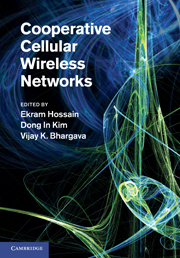Book contents
- Frontmatter
- Contents
- List of contributors
- Preface
- Part I Introduction
- Part II Cooperative base station techniques
- Part III Relay-based cooperative cellular wireless networks
- Part IV Game theoretic models for cooperative cellular wireless networks
- 13 Coalitional games for cooperative cellular wireless networks
- 14 Modeling malicious behavior in cooperative cellular wireless networks
- Part V Standardization activities
- Index
14 - Modeling malicious behavior in cooperative cellular wireless networks
from Part IV - Game theoretic models for cooperative cellular wireless networks
Published online by Cambridge University Press: 03 May 2011
- Frontmatter
- Contents
- List of contributors
- Preface
- Part I Introduction
- Part II Cooperative base station techniques
- Part III Relay-based cooperative cellular wireless networks
- Part IV Game theoretic models for cooperative cellular wireless networks
- 13 Coalitional games for cooperative cellular wireless networks
- 14 Modeling malicious behavior in cooperative cellular wireless networks
- Part V Standardization activities
- Index
Summary
Introduction
Future communication systems will be decentralized and ad-hoc, hence allowing various types of network mobile terminals to join and leave. This makes the whole system vulnerable and susceptible to attacks. Anyone within communication range can listen to and possibly extract information. While these days we have numerous cryptographic methods to ensure high-level security, there is no system with perfect security on the physical layer. Therefore, the physical layer security is attracting renewed attention. Of special interest is so-called information-theoretic security since it concerns the ability of the physical layer to provide perfect secrecy of the transmitted data.
In this chapter, we present different scenarios of a decentralized system that protects the broadcasted data on the physical layer and makes it impossible for the eavesdropper to receive the packets no matter how computationally powerful the eavesdropper is. In approaches where information-theoretic security is applied, the main objective is to maximize the rate of reliable information from the source to the intended destination, while all malicious nodes are kept ignorant of that information. This maximum reliable rate under which a perfectly secret communication is possible is known as the secrecy capacity.
This line of work was pioneered by Aaron Wyner, who defined the wiretap channel and established the possibility of secure communication links without relying on private (secret) keys.
- Type
- Chapter
- Information
- Cooperative Cellular Wireless Networks , pp. 382 - 422Publisher: Cambridge University PressPrint publication year: 2011
- 4
- Cited by



